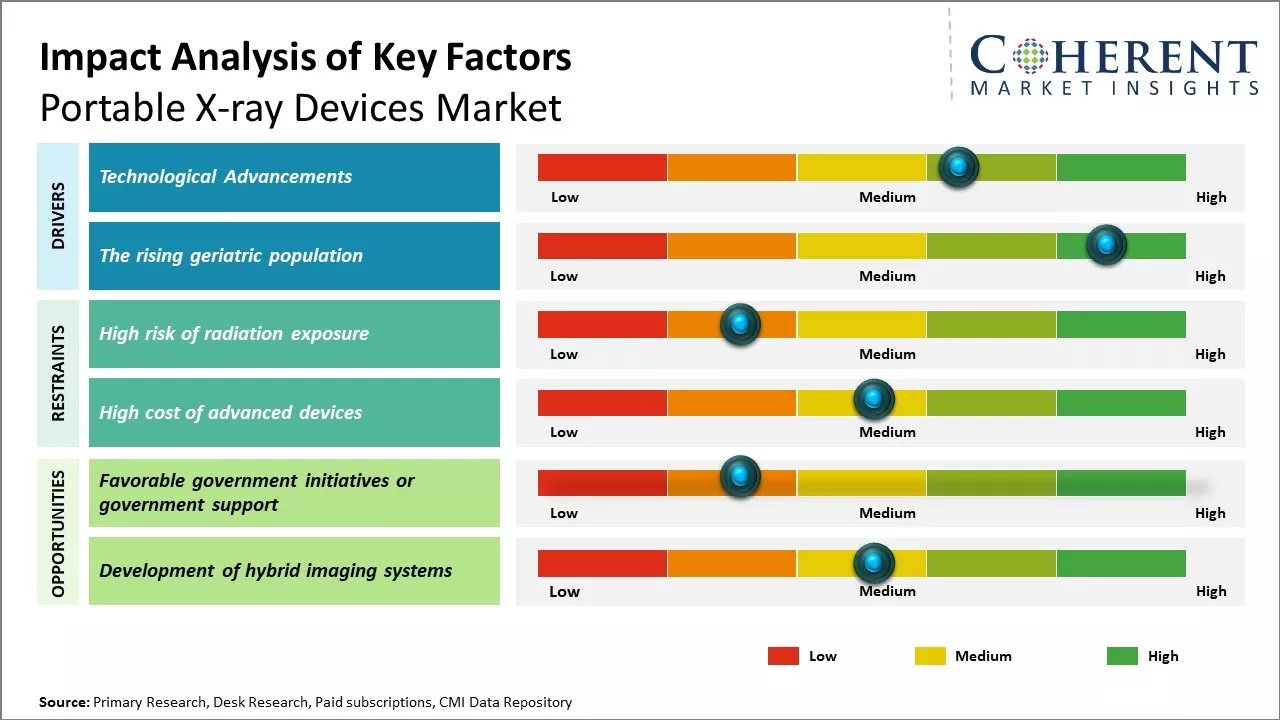The portable X-ray devices market is estimated to be valued at USD 8.99 billion in 2025 and is expected to reach USD 16.98 billion by 2032, exhibiting a compound annual growth rate (CAGR) of 9.5% from 2025 to 2032.

Discover market dynamics shaping the industry: Download Free Sample
The market is driven by the rising aging population and the subsequent growth in the incidence of age-related diseases as well as increasing healthcare expenditure. Portable x-ray devices offer mobility and flexibility which enables radiological diagnosis to be conducted at the point-of-care or at ambulant sites. This advantage has been the key factor fueling the demand for portable x-ray devices globally. The increasing demand for home healthcare and telehealth owing to the COVID-19 pandemic has further promoted the adoption of portable x-ray devices in recent times.
Technological Advancements
One of the major drivers propelling the growth of the portable X-ray devices market is the advancing technologies that are helping make these devices more portable and affordable. With continuous innovation and R&D, manufacturers are able to pack more powerful imaging capabilities into smaller footprints without compromising on image quality. This has made portable X-ray machines viable options for use even in home care and ambulances in addition to hospitals and clinics.
The advanced digital detectors have enabled miniaturization while still obtaining high-resolution images equivalent to traditional larger machines. This has boosted the demand for portable X-ray devices significantly among healthcare providers. For instance, in March 2021, Fujifilm India Private Limited, a subsidiary of Fujifilm Holdings Corporation, a medtech company, introduced a mobile digital radiology system named FDR nano. This system delivers high-resolution images while minimizing X-ray doses in healthcare environments. According to the company, FDR nano incorporates noise reduction circuits that enhance the clarity of low-density areas, resulting in superior image quality.

Get actionable strategies to beat competition: Download Free Sample
The rising geriatric population
The global portable X-ray devices market is anticipated to experience growth propelled by the expanding geriatric population worldwide. The increasing number of imaging diagnostics, driven by the aging demographic and the wider acceptance of portable systems across diagnostic facilities, is contributing to this surge. For instance, according to the World Health Organization (WHO), the global population aged 60 years and older is projected to double by 2050, reaching 2.1 billion, while the number of individuals aged 80 years or older is expected to triple between 2020 and 2050, reaching 426 million.
The introduction of innovative products by market players is also expected to fuel the growth of the global portable X-ray devices market. For example, as reported in the 2021 Knoema journal, Argentina witnessed a rise in its population aged 65 years and older to 11.5% in 2021, with this demographic segment growing at an average annual rate of 0.95%. Given that the elderly population is susceptible to a range of ailments, the demand for portable digital X-ray devices is expected to escalate. Diagnostic imaging equipment is indispensable for diagnosing numerous illnesses, making it a crucial requirement amid the burgeoning geriatric population.
Key Takeaways of Analyst:
The portable X-ray devices market shows promising growth opportunities over the next five years. The primary drivers for this growth include the rising geriatric population globally that are more prone to injuries and orthopedic conditions. Furthermore, the increasing preference for point-of-care diagnosis is also fueling demand for portable X-ray devices. These devices allow for quick diagnosis and treatment without moving patients, which is more convenient for both healthcare providers and patients.
The Asia Pacific region is projected to be the fastest growing regional market due to progressing healthcare infrastructure and rising medical tourism in countries like India and China. North America will continue to dominate the portable X-ray devices landscape however due to well-established healthcare systems and early technology adoption in the region.
While rising demand from emerging markets offers opportunities for expansion, pricing pressures and regulatory barriers pose challenges to business growth. Stringent approval processes increase a company’s time to market and marketing costs. Additionally, the presence of local manufacturers supplying low-cost devices acts as a restraint in certain developing countries.
Market Challenges: High risk of radiation exposure
Elevated danger of radiation exposure is anticipated to impede the expansion of the worldwide market for portable x-ray machines. The risks linked with medical imaging treatments refer to the potential negative effects, whether short-term or long-term, that may arise. Numerous side effects, including vomiting, hemorrhage, fainting, hair loss, and skin and hair loss, can result from severe radiation exposure. X-rays have a very minimal risk of side effects, while being associated with a slightly higher risk of cancer. Product recalls are anticipated to impede the expansion of the worldwide market for portable x-ray devices. For instance, the Food and Drug Administration (FDA) noted that Shimadzu Medical Systems USA recalled a mobile x-ray system (SHIMADZU MobileDaRt Evolution (MX8 Version) in January 2019 due to a documented design flaw.
Market Opportunities: Favorable government initiatives or government support
Favorable governmental initiatives or support are poised to present attractive growth prospects for participants in the worldwide portable X-ray devices market. For example, in July 2022, Member of Parliament Kanimozhi from Thoothukkudi, Tamil Nadu, India, unveiled a digital mobile X-ray diagnostic unit aimed at tuberculosis detection. This initiative falls under the National Tuberculosis Elimination Programme (NTEP), where tuberculosis diagnosis and treatment are provided free of charge with high-quality equipment and medications in the district. The escalating demand for portable X-ray devices globally is anticipated to create lucrative growth avenues for market players. For instance, in July 2022, Fujifilm Europe announced the introduction of the FDR CROSS, a novel hybrid C-arm and portable X-ray device.

Discover high revenue pocket segments and roadmap to it: Download Free Sample
Insights, By Technology: Convenience and Cost-effectiveness Drive Analog X-ray Adoption
In terms of technology, analog x-ray contributes the highest share of the market 60.6% owing to its convenience and affordable price relative to digital options. Analog X-ray devices rely on traditional photographic film to capture images, foregoing the need for complex digital components and software. This simplicity allows analog machines to remain highly portable while maintaining a smaller physical footprint compared to digital alternatives. The lack of a digital display or imaging plate means analog X-rays can be immediately developed using standard darkroom procedures, expediting diagnosis and treatment. Additionally, the up-front costs of analog machines are significantly lower than digital devices. While film, chemicals, and darkroom equipment introduce ongoing consumable expenses, the initial capital investment in an analog unit is attractively affordable for cash-strapped clinics and practices. Recouping development costs is also faster, as recurring film and processing fees accumulate over the lifespan of the machine. For cash-pay and budget-focused facilities, analog technology delivers necessary functionality at minimum upfront pricing.
Insights, By Application: Rapid Screening and Early/ Detection Drive Mammography Adoption
In terms of application, mammography contributes the highest share 45.94% in 2025 significantly owing to its effectiveness in breast cancer screening and early detection. Being one of the few modalities capable of visualizing soft breast tissue with high resolution, portable mammography units play a vital role in early-stage cancer identification. Their mobility allows screening in remote clinics or via mobile vans, improving access for underserved populations. Further, the non-invasive nature of mammography makes it suited for annual screenings encouraged for women over 40.
Routine breast screenings using portable mammography have proven instrumental in catching potentially malignant abnormalities at their earliest and most treatable stages. Finding tumors before they grow large or spread to lymph nodes gives patients the highest chances of remission through localized surgeries or therapies alone. This potential for initial detection boosts willingness among physicians and patients to adopt mammography in primary care settings. With over 250,000 new cases of invasive breast cancer estimated to be diagnosed in the U.S. alone in 2021, demand remains robust for technologies that can maximize early warning opportunities.
Insights, By Modality: Ubiquity and Flexibility Drive the Adoption of Handheld
In terms of modality, handheld x-ray devices contribute the largest portion of the market 59.8% in 2025 due to their unparalleled portability and flexibility compared to mobile units. Truly portable systems can accompany providers anywhere in ambulatory care environments, giving internal medicine physicians, ER doctors, physician assistants, and others immediate access to diagnostic-quality scans. Avoiding the need to transport patients to fixed imaging centers streamlines workflows and clinical decision-making at the point of care.
Further, handhelds free practitioners from dependence on centralized radiology departments. Specialists like orthopedists, urologists, and cardiologists gain autonomy in positively identifying fractures, locating medical devices, and monitoring chronic conditions during office visits or surgical procedures. Whether weighing an emergent case for surgery, adjusting a treatment plan based on progress, or attending to an injured athlete on the sidelines, a pocket-sized X-ray system ensures decisions rely on up-to-date imaging rather than proxy indicators or clinical assumptions.

Need a Different Region or Segment? Download Free Sample
North America has established itself as the dominant regional market for portable X-ray devices.with high share of 39.7% in 2025. The region enjoys a strong presence of key industry players with major companies like GE Healthcare, Philips, and Siemens Healthineers having their headquarters in the U.S. These companies have been operating in the region for several decades and have strengthened their distribution and service networks. The presence of major universities and research institutions have also contributed to the technological advancements occurring in the industry.
The Asia Pacific region has emerged as the fastest growing regional market for portable X-ray devices. Rapid economic growth along with rising healthcare expenditure and improving access to healthcare services across developing countries like China and India are driving the market growth. There is a growing focus on modernizing the healthcare infrastructure and increasing the penetration of medical technologies in rural and remote locations, which is propelling the adoption of portable X-ray devices in the region. Additionally, the presence of leading global players as well as the establishment of domestic manufacturers are helping in boosting the affordability of products. This has enabled more hospitals, clinics as well as diagnostic centers to invest in portable X-ray solutions. The growing medical tourism industry along with expat population in countries like Singapore is further augmenting the demand.
Portable X-ray Devices Market Report Coverage
| Report Coverage | Details | ||
|---|---|---|---|
| Base Year: | 2024 | Market Size in 2025: | USD 8.99 Bn |
| Historical Data for: | 2020 To 2024 | Forecast Period: | 2025 To 2032 |
| Forecast Period 2025 to 2032 CAGR: | 9.5% | 2032 Value Projection: | USD 16.98 Bn |
| Geographies covered: |
|
||
| Segments covered: |
|
||
| Companies covered: |
Envista Holdings Corporation (KaVo Dental GmbH), Canon Medical System, GE Healthcare, Koninklijke Philips NV, MinXray, FUJIFILM Holdings Corporation, Shimadzu Corporation, Siemens Healthineers AG, Carestream Health Inc., General Electric, Siemens Healthcare, Ziehm Imaging GmbH, MinXray, Inc, Samsung Electronics Co., Ltd., Hitachi, Ltd., Source-Ray, Inc., Hologic, Inc. |
||
| Growth Drivers: |
|
||
| Restraints & Challenges: |
|
||
Uncover macros and micros vetted on 75+ parameters: Get instant access to report
*Definition: The portable x-ray devices market consists of medical imaging devices that use x-ray radiation to generate images of parts of the body. These portable devices are compact, lightweight, and battery-powered, making them ideal for use in various healthcare settings such as emergency rooms, operating rooms, ICUs, and for remote and point-of-care applications.
Share
Share
About Author
Manisha Vibhute is a consultant with over 5 years of experience in market research and consulting. With a strong understanding of market dynamics, Manisha assists clients in developing effective market access strategies. She helps medical device companies navigate pricing, reimbursement, and regulatory pathways to ensure successful product launches.
Missing comfort of reading report in your local language? Find your preferred language :
Transform your Strategy with Exclusive Trending Reports :
Frequently Asked Questions
Joining thousands of companies around the world committed to making the Excellent Business Solutions.
View All Our Clients